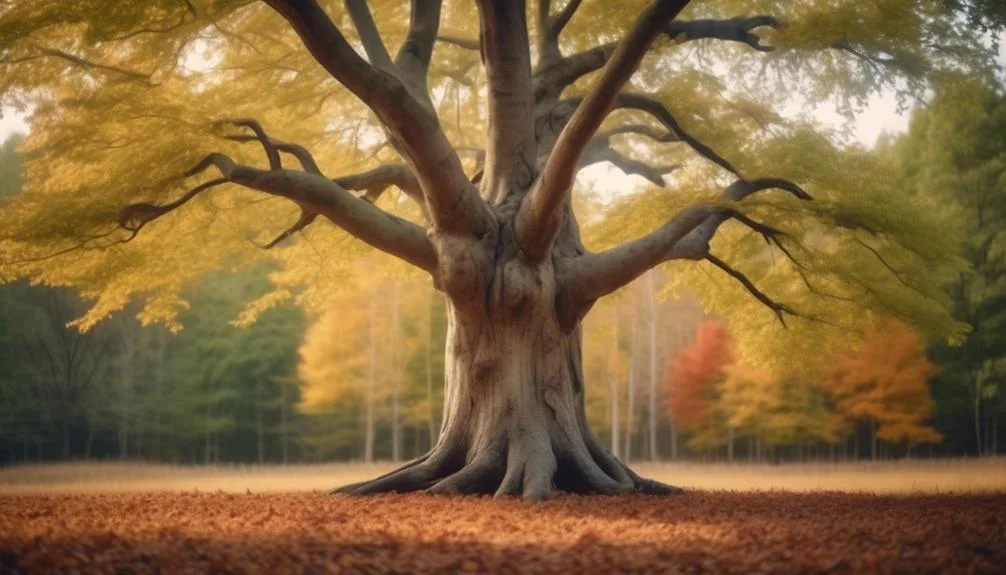Have you ever wondered if hickory trees can grow alongside other plant species? Understanding how hickory trees interact with neighboring plants can help us learn more about forest ecosystems and sustainable land management.
Can hickory trees coexist with other species, and what factors affect this balance? Let's explore the compatibility of hickory trees with other plants to gain insights into ecological relationships and how this knowledge can benefit the environment.
Hickory Trees' Compatibility With Other Species
Hickory trees thrive in mixed forests, coexisting harmoniously with a variety of other species, contributing to the rich biodiversity of their ecosystems.
Their compatibility with other species is crucial for maintaining tree diversity and minimizing environmental impact.
Hickory trees play a vital role in regulating soil nutrients by influencing the composition of the forest floor. They compete with other species for root space, which can impact the availability of nutrients and water.
This competition, although natural, can influence the overall health and growth of neighboring plants. Understanding the dynamics of root competition among different species is essential for managing forest ecosystems sustainably.
Factors Affecting Hickory Trees' Growth With Other Species
Considering the complex web of interactions within mixed forests, it's essential to understand the factors that influence the growth of hickory trees alongside other species. When hickory trees grow next to other species, several factors come into play:
- Competition Effects: Different species compete for resources such as sunlight, water, and nutrients, which can impact the growth of hickory trees.
- Symbiotic Relationships: Some species may have symbiotic relationships with hickory trees, benefiting each other's growth through processes like nitrogen fixation or mutual protection from pests.
- Soil Composition: The composition of the soil can affect the availability of nutrients for hickory trees and other species, influencing their growth patterns.
- Canopy Structure: The structure of the canopy can impact light availability, affecting the growth of hickory trees and neighboring species.
- Disturbances: Natural disturbances such as fires or human activities can alter the dynamics of growth interactions among different species in a mixed forest.
Ideal Companion Plants for Hickory Trees
When cultivating a mixed forest, it's essential to select companion plants that complement the growth of hickory trees and contribute to a balanced ecosystem. When choosing ideal companion plants for hickory trees, consider their impact on soil composition, shading, nutrient competition, and root systems.
Plants that thrive in similar soil conditions and have non-competitive root systems make excellent companions for hickory trees. Additionally, selecting plants that provide shade without overshadowing the hickory trees is crucial. Some suitable companion plants for hickory trees include wild ginger, foamflower, and woodland phlox.
These plants not only thrive in similar soil compositions but also complement the hickory trees by providing ground cover and creating a harmonious environment. By carefully considering the interactions between hickory trees and companion plants, you can create a thriving and balanced ecosystem within your mixed forest.
Potential Challenges of Growing Hickory Trees Next to Other Species
Growing hickory trees next to other species may present challenges such as root competition and shading effects on understory plants. The potential challenges of growing hickory trees next to other species include:
- Interspecies competition: Hickory trees have extensive root systems that can compete with other plants for water and nutrients.
- Allelopathic effects: Some hickory species release allelopathic compounds that inhibit the growth of nearby plants, affecting their health and development.
- Nutrient sharing: While hickory trees can benefit from nutrient sharing with certain species, they may also outcompete others, leading to nutrient deficiencies in neighboring plants.
- Shading effects: Hickory trees' dense foliage can cast shade, limiting sunlight and affecting the growth of understory plants.
- Root systems: The extensive and deep-reaching root systems of hickory trees can potentially disrupt the growth of neighboring plants, particularly those with shallow roots.
Consider these factors when planning the arrangement of hickory trees with other species in a mixed planting environment.
Tips for Successful Coexistence of Hickory Trees and Other Species
To ensure the successful coexistence of hickory trees and other species, carefully consider their spatial arrangement and the specific needs of each plant. Proper tree spacing is crucial to minimize competition for resources.
Hickory trees are deep-rooted, so when planting them alongside shallow-rooted species, ensure sufficient distance between them to avoid competition for water and nutrients.
Additionally, understanding the soil nutrients required by each species is essential for successful coexistence. Some species may deplete specific nutrients from the soil while others enrich it.
Conclusion
In harmonizing hickory trees with other species, thoughtful consideration of compatibility, environmental conditions, and care is essential. This fosters a thriving coexistence and enhances the beauty of the surrounding plants. Understanding and meeting the needs of each species creates a harmonious garden or landscape.
How might this approach enrich your own gardening endeavors?
Mark Hoffman is a dedicated arborist and tree care specialist with over a decade of experience. His love for trees began when he visited Yosemite National Park as a teenager and was awestruck by the giant sequoias. Mark pursued his passion by studying forestry at Michigan Technological University, where he earned a Bachelor of Science degree.
Since then, he has worked tirelessly in the field of arboriculture, helping to preserve and protect trees in his community. His expertise and dedication have made him a respected leader in the industry and a valuable resource for anyone seeking advice on tree care.
